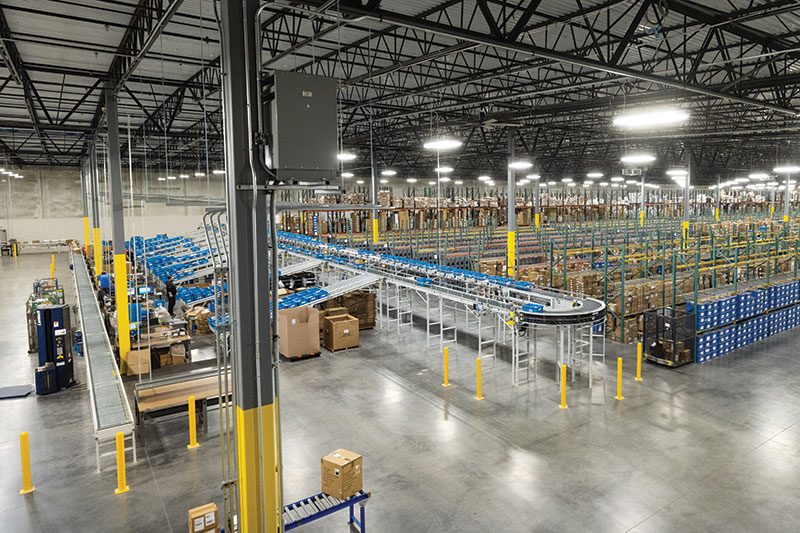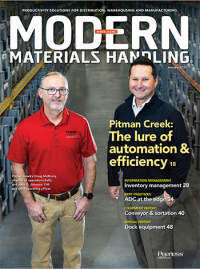Pitman Creek: The lure of automation and efficiency
Pitman Creek, one of the largest distributors of freshwater fishing tackle in North America, consolidated and expanded space in a new automated facility. The result: a 250% improvement in picking efficiency.
Small, fast-growing companies are often reactive rather than proactive. They have no choice: They’re running so fast to take advantage of new sales opportunities that their fulfillment operations can barely keep pace. Operations end up sprawled across multiple facilities, with labor and manual operations muscling orders out the door. They get the job done until they reach that point where it’s not feasible to just throw more labor at the problem.
That was the situation at Pitman Creek Wholesale. Based in Kentucky, Pitman Creek is one of the largest players in an industry that otherwise flies under the radar—sportfishing lures and tackle, with a deep specialization in bass fishing.
Until 2020, Pitman Creek fit that description of a fast-growing company just trying to keep up with explosive growth: In an eight-year period, sales increased by almost 600%. Along with those extra sales, the company also expanded its inventory and service offerings, providing just-in-time and vendor-managed-inventory services to big box and mom-and-pop retailers. At the same time, e-fulfillment and drop shipment services on behalf of its customers was also a growing channel.
“Back in 2015, we moved into a 40,000-square-foot facility and thought we’d be there for five years,” recalls John D. Johnson, Pitman Creek GM and chief operating officer. “A few years later, we had 100,000 square feet spread across multiple satellite facilities, and everything was manual.”
The solution was two-fold. The first move was to consolidate the bulk of its operations into a new 205,000-square-foot facility in late 2020—that original 40,000-square-foot facility is also still in operation; the second was to bring in automation, including conveyor and sortation. The conveyor system transports newly received merchandise from receiving to storage areas and sorts order totes to packing stations. From there, outbound cartons are automatically weighed, cubed and labeled before they’re conveyed to shipping. The warehouse operations are directed by a warehouse management system (WMS) that uses Apple iPads for mobile computing (HOJ and WarehouseOS).
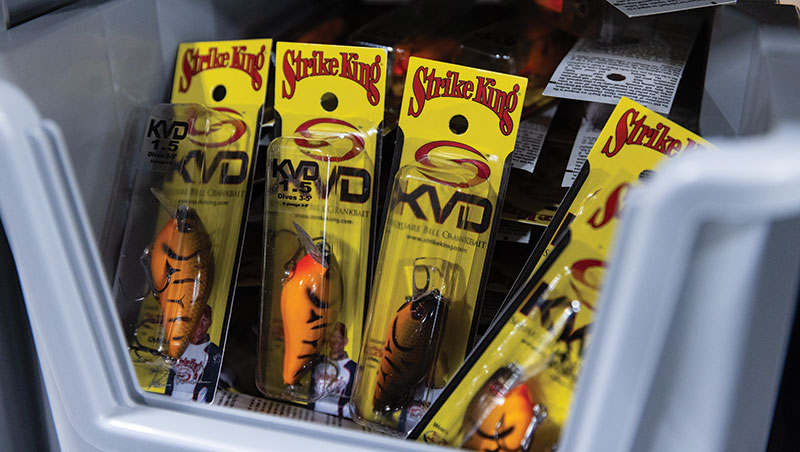
A big advantage of the WMS and the design: Pitman Creek was able to maintain fulfillment processes that were working well in the satellite facilities while significantly improving on its operational metrics.
“Yesterday, our pickers were picking product and then moving product,” says Johnson. “Today, our pickers pick, our packers pack, and our conveyor and sortation equipment moves the product.” The result, he adds, has been a 400% improvement in receiving operations to putaway and a 250% improvement in outgoing production. The facility moves roughly 500,000 units per week and shipped north of 25 million units in 2020. That’s a lot of lures.
From regional to national distribution
According to Johnson and Pitman Creek director of operations, Doug McMurry, the company has gone through a number of changes since it was founded as a boutique manufacturer of bass fishing lures in Somerset, Ky., in 1978.
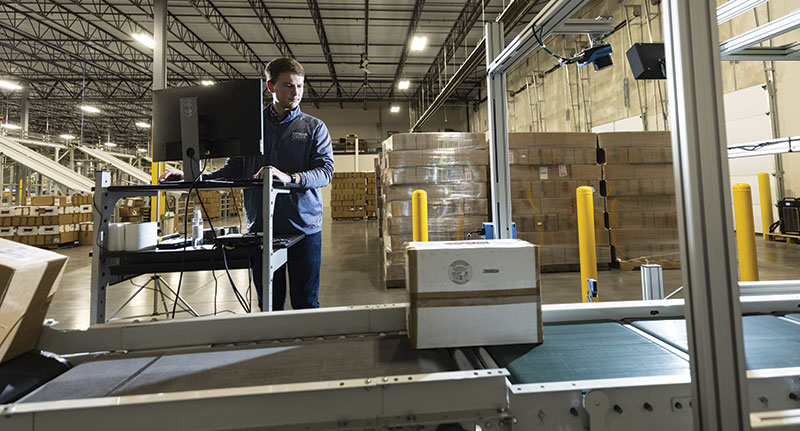
The founder, who is no longer involved in the business, was a marina owner who made lures on the side, primarily for his marina customers. The lures became so popular that he expanded operations, selling to other marinas and mom-and-pop outdoor recreation stores. Distribution was primarily from the owner’s van.
Still privately held, ownership changed in 1993. The new owner, James S. Coffey, president and CEO, began to expand into a traditional regional wholesale distributor, adding lines from other manufacturers.
Today, Pitman Creek is recognized as the largest fish and tackle distributor in the country, representing 300 different brands and shipping to more than 8,000 retail locations. Half the business is devoted to big box retailers while the rest is focused on the independent dealer businesses that traditionally made up the outdoor recreation industry.
Pitman Creek grew its business through a unique go-to-market strategy:
- Consolidate vendors: By representing so many brands, Pitman Creek offers one-stop shopping to its customers. What’s more, the company is constantly researching the market for new products and lures, freshening up the inventory for the anglers looking for something new in their tackle boxes.
- Vendor managing inventory: Pitman Creek assists in creating assortments of store/SKU selection for its retailers and then analyzes sales to ensure there is an in-stock selection of what’s selling best.
- Just-in-time delivery for the retailer: Thirty percent of the country can place an order by 2 p.m. on Monday and get delivery by 10 a.m. on Tuesday. “That makes us unique in the industry because a retailer doesn’t have to plan,” Johnson says. “They can utilize just-in-time inventory.”
- e-fulfillment: Pitman Creek does not sell direct-to-the-consumer, but it does provide e-fulfillment services for some independent dealers and big box retailers. “When we pick an order for a retailer partnering with us for a vendor direct fulfillment solution, we pack it and ship it as if it came directly from that retailer.” Although e-fulfillment is still a relatively small piece of the business, it has grown from a handful of orders per day, with one to two units per order to more than 200 orders per day with three to five units per order in just a few years, with no sign of letting up. Pitman Creek is currently averaging 2,000 e-commerce orders per week, and has the ability to scale to more than 2,000 orders per day.
Automating for growth
The most important change to the business that impacted distribution activities was the growth of the big box retail channel. That started about seven years ago. At the time, Pitman Creek was considered a regional distributor with a good selection of hard-to-get items popular in the southeastern United States. The company did very little business with big box retailers.
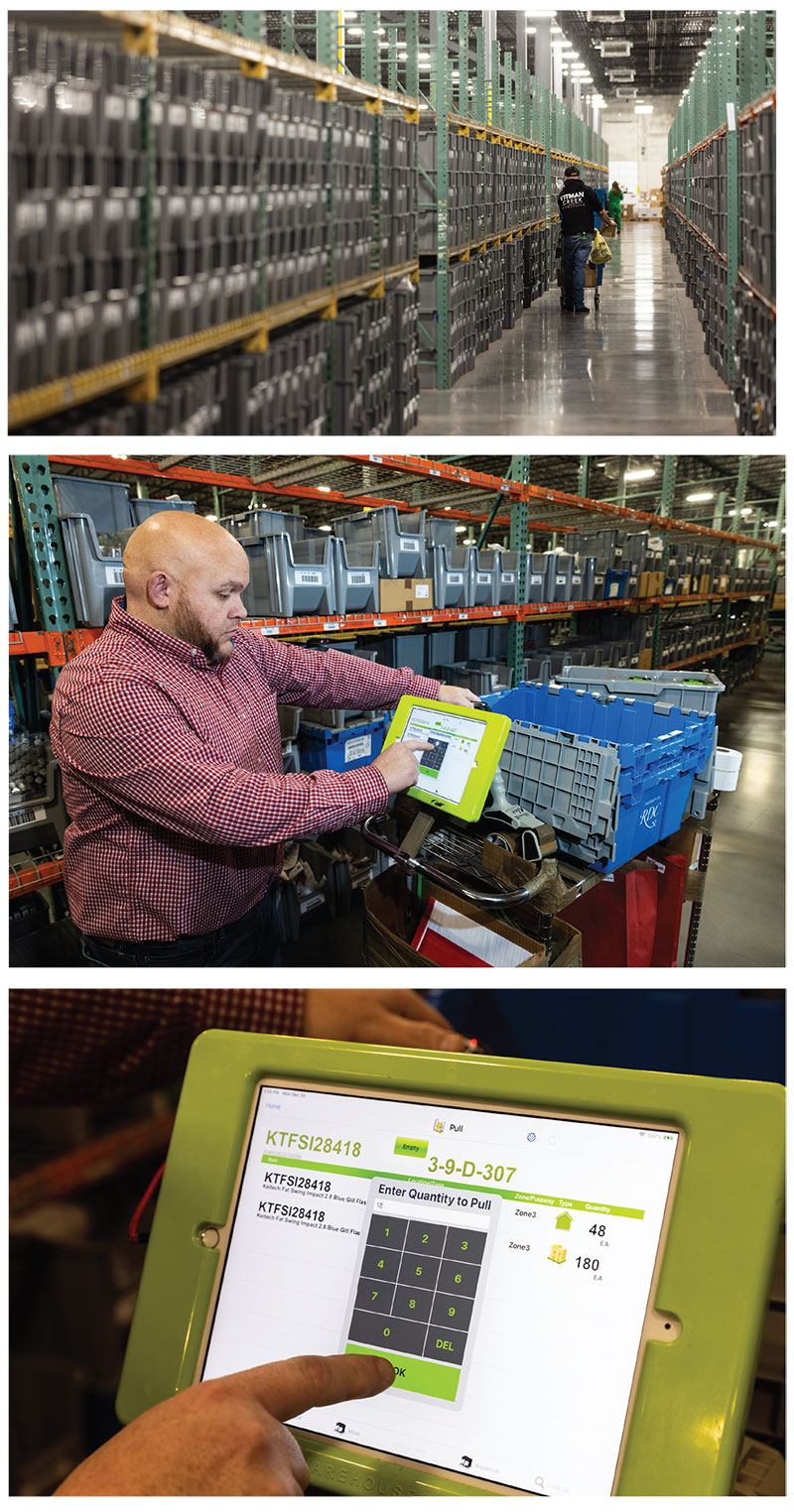
Around that time, it began discussions to provide inventory to about 300 Dick’s Sporting Goods stores in the Southeast. “One of the things we did was to analyze what they were stocking in those stores to help them freshen up their assortment of lures,” Johnson recalls. The analysis worked. Soon, Dick’s represented about 5% of the company’s business and the sales team took what it learned from that first foray into big box retailing and began to apply it to other accounts.
Business took off. In 2015, Pitman Creek moved from a 20,000-square-foot facility into a 40,000-square-foot facility, with intentions of staying anchored for five years. But as sales continued to grow, it soon had 100,000 square feet spread across multiple satellite facilities. Another opportunity arose when a large competitor filed for bankruptcy in 2017, creating a hole in the industry that many major accounts looked to Pitman to fill.
“About then, the light bulb went off that if we were going to continue on our growth path, we had to put everything under one roof and bring in automation,” Johnson recalls. Company leadership was leery about investing in a new facility because one of the things that led to the bankruptcy of that competitor was a large investment into a new distribution center. The decision was made to keep doing what they were doing unless sales really took off.
That happened in April 2020, when a major competitor ran into order fulfillment challenges during Covid. “We never had to shut down, and our independent dealer business grew dramatically,” Johnson says. To keep operating during a pandemic, all hands were on deck in the warehouse, including company leadership. In July 2020, the company owner gave the green light to consolidate all that satellite space into a new facility, with room to grow. Pitman Creek Wholesale broke ground in October 2020 and was fully operational less than a year later.
If it ain’t broke, don’t fix it
Before choosing a partner to design the new facility, Pitman Creek consulted with several system integrators. Most recommended a complete makeover of picking processes, such as moving away from discrete order picking to batch picking. Instead, Pitman Creek decided to work with the system integrator that implemented its WMS some years earlier because they took an “if it ain’t broke, don’t fix it” approach to design.
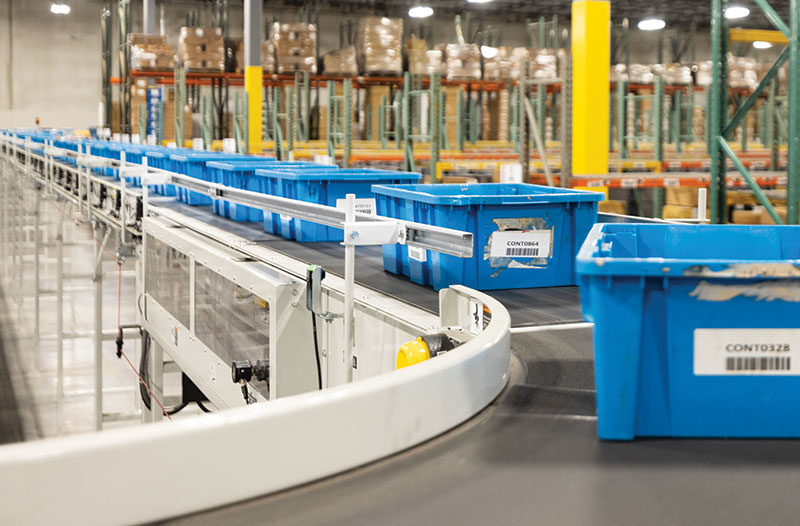
“We were growing at an exponential rate and didn’t want to change processes that were working for us,” says director of operations Doug McMurry. “Instead, we wanted to automate those processes, consolidate operations under one roof and have room to grow in the future.”
An example of a process that was working, but needed improvement, was discrete zone picking. A typical order, for instance, might require items from five zones. Rather than sending one individual through all five zones to fill that order, the WMS assigned orders by zone. In the manual operation, order selectors would pick their assignment complete and then take the totes to an area where all of the totes for an order were married, and then manually delivered to packing.
To further complicate things, items for an order might get picked in multiple facilities. “HOJ understood that batch picking wouldn’t work for us because of our order velocity,” McMurry says. “So, we worked on how to automate our manual processes so our pickers weren’t walking 20,000 steps a day.”
To reduce steps, inventory was slotted so the most frequently picked items were stored nearest the conveyor. An order selector could pick 72% of most orders in the four rows nearest the conveyor and complete 97% in the eight rows nearest the conveyor.
“A picker can spend a fair amount of their time in just the section of their zone where the fastest moving items are stored,” Johnson says. Further, the distributor installed a recirculating conveyor that is used as buffer storage until all of the totes needed for an order have been picked complete and can be sorted to a packing station. That meant associates no longer had to consolidate totes and then manually deliver them to packing.
Speed to the shelf was another area targeted for improvement. “Our goal is to have enough inventory in a pick slot to fill today’s orders, with about 30 days in backstock,” McMurry says. “That means we get regular deliveries of items we sell all the time and have to get them processed and ready to be picked quickly.”
A final objective was to optimize storage and access to inventory. “By redesigning the facility, we not only increased our space, but we increased the amount of pallet racking we had by a factor of three, in part by holding back stock on the back side of a pick location,” notes Johnson.
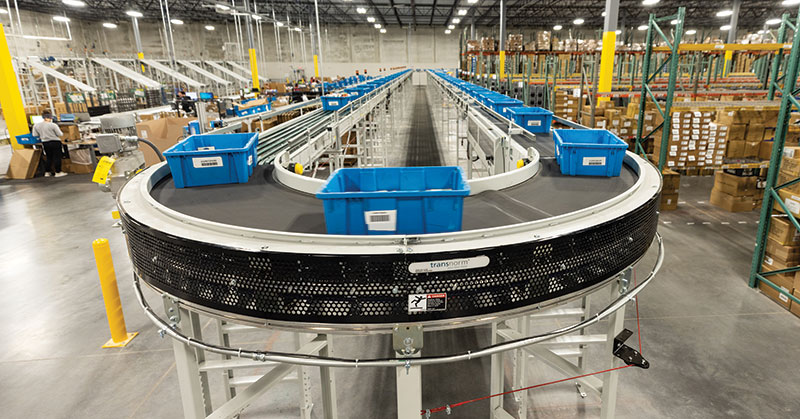
To optimize storage, Pitman Creek performed a slotting and bin size analysis. The goal was to create a system to optimize space while holding that 30-day supply at the pick locations. The amount of storage space and bin sizes was determined by the velocity of the different parts.
Putting it all together
The new design is simple but effective, making the best use of the existing WMS and the new conveyor and sortation and automated cubing, weighing and labeling equipment.
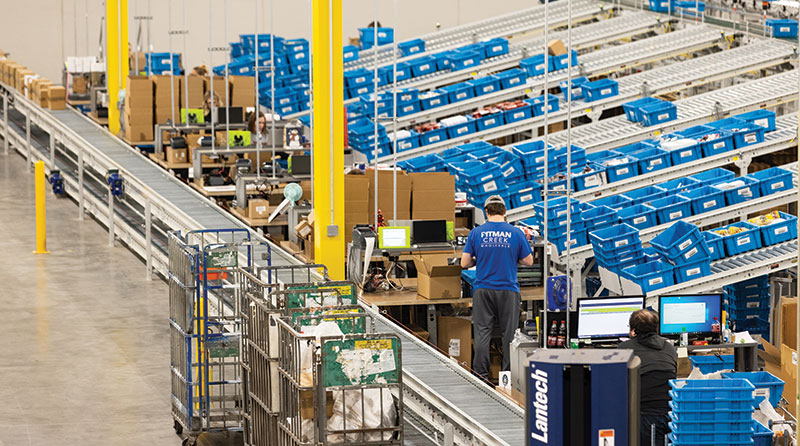
Once new inventory has been entered into the WMS, associates decant cartons into the right-sized bin for storage. Bins are then inducted onto the conveyor system and transported to a zone for putaway into buffer storage behind the pick face. Having reserve inventory located next to the pick location speeds up replenishment.
Orders are picked complete rather than batched. But, since an order may involve merchandise from more than one zone, the WMS allocates picking tasks by zone. Associates receive their tasks and update the WMS on an iPad. Items are picked to a cart; once a zone is picked complete, associates induct their totes onto the conveyor system.
The totes circulate until all of the totes for an order are available and are sorted to an available packing station. After packing, shipping cartons are automatically cubed and weighed, and if they are within tolerances, they are automatically labeled and sorted to the shipping area to be palletized and wrapped if required, or loaded onto a parcel carrier.
McMurry notes that the go-live was not without its challenges, but that the simplicity of the design and using familiar processes helped them get through it without missing a shipment. “We were in a very good spot,” he says. “If I had it to do over, I would have done more testing since we had never used a conveyor and sortation system in the past. But, we were still able to make deliveries to our customers.”
He adds that his associates have embraced the design and automation. In part, that’s because automation and the design made their old jobs a lot easier. “They have more room in the aisles to work and the new facility is much better lit than the old facility,” McMurry says. “And, by locating backstock adjacent to a pick location, replenishment is so much easier.”
McMurry and Johnson both say the new facility positions Pitman Creek to continue its growth path and maintain the customer service edge it has in the industry. It opens the door to bring in more SKUs, perhaps expand into new niches and pick orders faster. “We have space to expand and we can utilize more overhead space to increase the cube. We have built ourselves for future growth.”

Article Topics
Automation News & Resources
Materials Handling Robotics: The new world of heterogeneous robotic integration Coles automates grocery distribution in Australia 2024 Intralogistics Robotics Survey: Robot demand surges Up close and personal with mind twisting special purpose robots Warehouse automation extends life of cheese DC by a decade C-Suite Interview with Knapp’s Josef Mentzer: MODEX 2024 eclipses expectations MEGALINEAR MLR-45: Innovation in Logistics and Material Handling More AutomationLatest in Materials Handling
Registration open for Pack Expo International 2024 Walmart chooses Swisslog AS/RS and software for third milk processing facility NetLogistik partners with Vuzix subsidiary Moviynt to offer mobility solutions for warehouses Materials Handling Robotics: The new world of heterogeneous robotic integration BSLBATT is looking for new distributors and resellers worldwide Lucas Watson appointed CSO for Körber’s Parcel Logistics business in North America Hyster recognizes Dealers of Distinction for 2023 More Materials HandlingAbout the Author
Subscribe to Materials Handling Magazine

Find out what the world's most innovative companies are doing to improve productivity in their plants and distribution centers.
Start your FREE subscription today.
April 2024 Modern Materials Handling

Latest Resources


